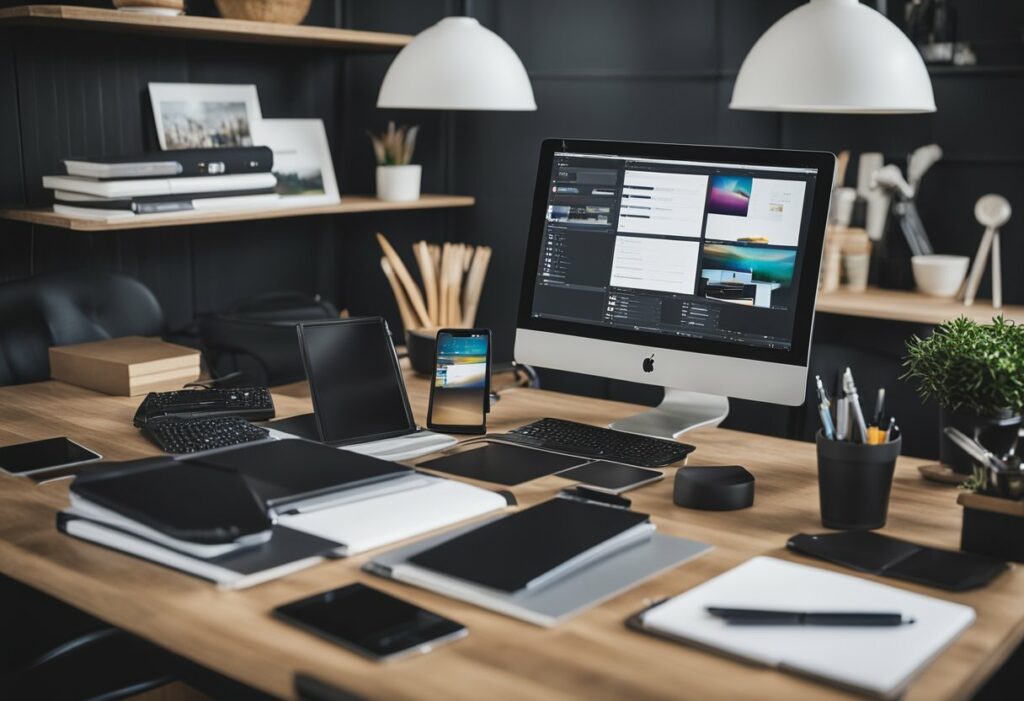Graphic Design Home Office: Tips for Creating a Productive Workspace
If you’re a graphic designer, you know how important it is to have a workspace that fuels your creativity. A well-designed home office can provide you with the perfect environment to let your ideas flow and bring your designs to life. But where do you begin? In this article, we’ll discuss how to create the perfect graphic design home office that inspires and motivates you.
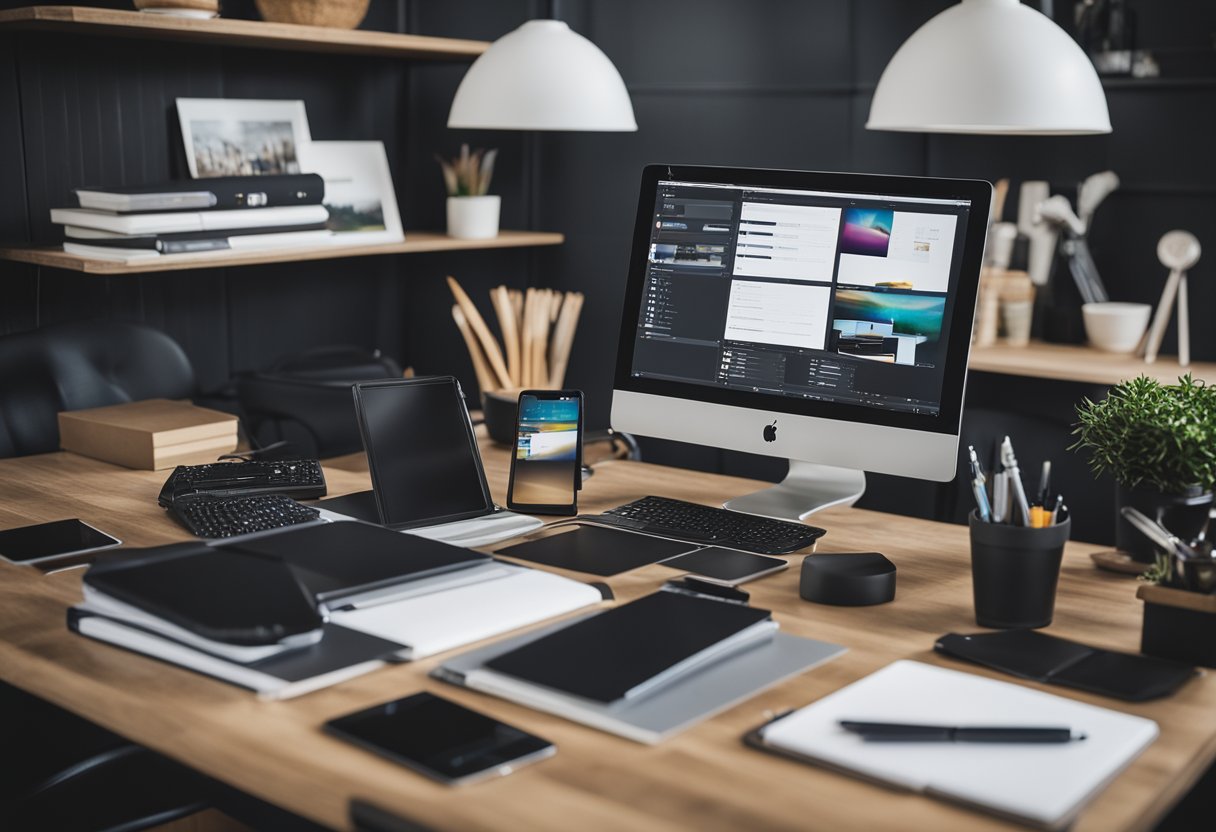
Designing your graphic design home office requires careful planning and investment in furniture, tools, and layout. You need to focus on creating an ergonomic, organised, and aesthetically inspiring workspace that sparks productivity. From the right desk and chair to the perfect lighting and colour scheme, every element of your home office should work together to enhance your creativity.
Personalising your creative space is also essential. You want to create an environment that reflects your personality and inspires you to do your best work. From the artwork on the walls to the plants on your desk, every element of your home office should be carefully chosen to create a space that is uniquely yours. So, let’s get started on creating the perfect graphic design home office that will help you take your work to the next level.
Key Takeaways
- Designing your graphic design home office requires careful planning and investment in furniture, tools, and layout.
- Your home office should be an ergonomic, organised, and aesthetically inspiring workspace that sparks productivity.
- Personalising your creative space is essential to create an environment that reflects your personality and inspires you to do your best work.
Designing Your Graphic Design Home Office
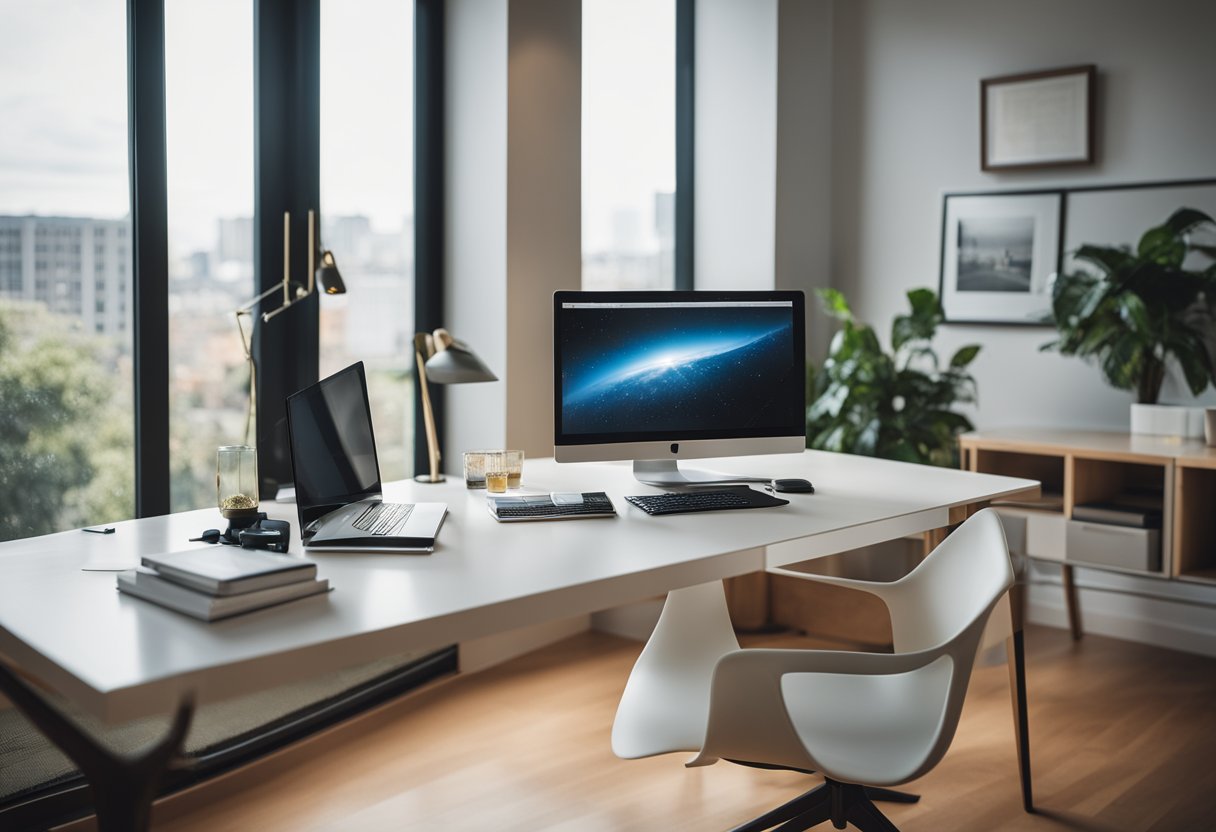
Designing your graphic design home office is an exciting process that requires careful consideration of various factors. Here are some essential tips to help you create a comfortable and productive workspace that inspires creativity.
Choosing the Right Space
When designing your graphic design home office, you need to choose the right space that suits your needs. Consider factors such as natural light, privacy, and noise levels. A den, shed, or spare room can make an excellent home studio. When selecting a space, ensure it is spacious enough to accommodate your workstation and other essential equipment.
Essential Furniture and Equipment
Essential furniture and equipment for your graphic design home office include a desk, chair, computer, and filing cabinet. Invest in an ergonomic chair with lumbar support to ensure maximum comfort while working. A spacious and organised desk is also essential for productivity. Consider a standing desk to promote good posture and reduce back pain. A filing cabinet will help you keep your supplies and documents organised.
Optimising Lighting and Environment
Natural light is essential for a productive and inspiring home office environment. Position your workstation near a window to maximise natural light. You can also invest in a lamp to supplement the natural light. Consider adding plants to your workspace to create a calming and inspiring environment.
Workspace Organisation and Productivity
An organised workspace is essential for productivity. Keep your desk clutter-free and ensure everything has its designated place. Use storage solutions such as shelves, drawers, and filing cabinets to keep your supplies and documents organised. Consider using a productivity app or tool to manage your tasks and deadlines.
Technology and Software for Graphic Designers
As a graphic designer, you need to invest in the right technology and software to stay productive. Consider using a Mac, iMac, MacBook, or MacBook Pro for your graphic design work. Software such as GIMP is an excellent tool for digital art and graphic design. Ensure your computer has enough memory and processing power to handle complex design projects.
In conclusion, designing your graphic design home office requires careful consideration of various factors such as space, furniture, lighting, and technology. By following these essential tips, you can create a comfortable and productive workspace that inspires creativity.
Personalising Your Creative Space
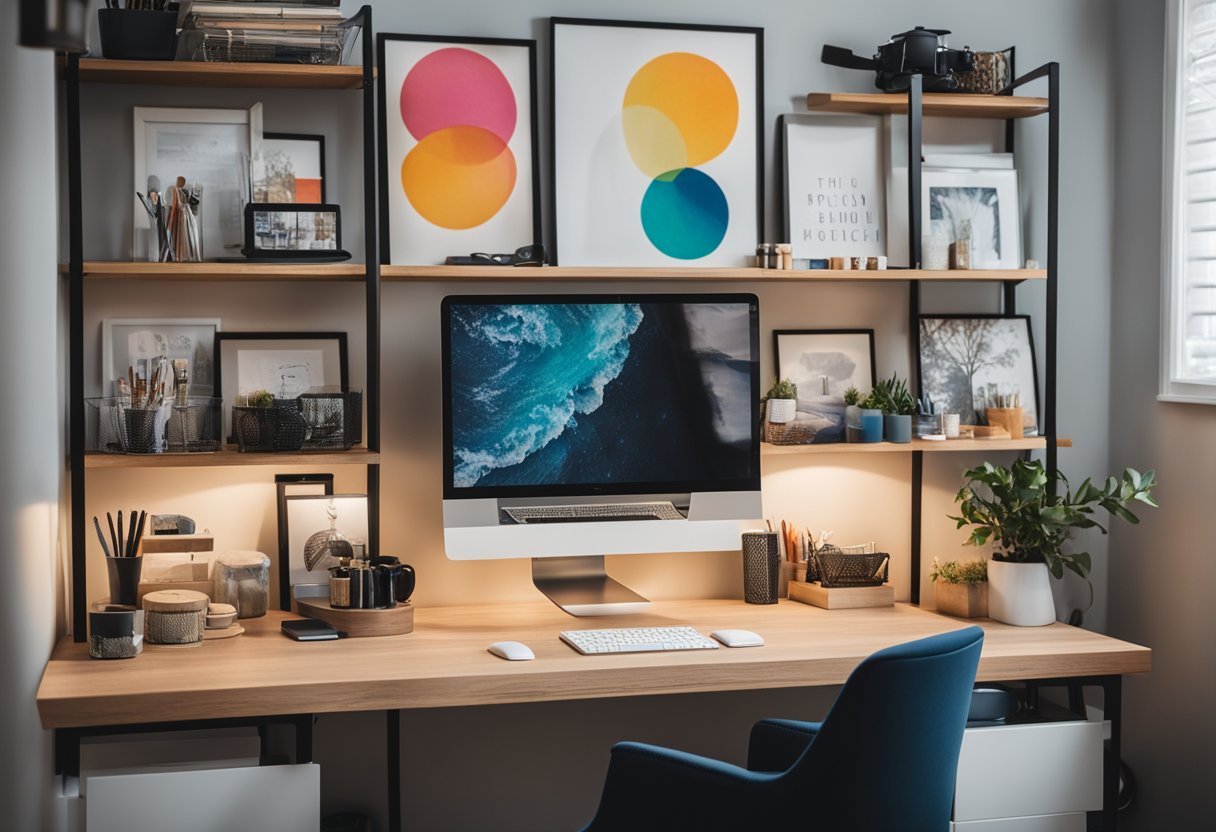
As a graphic designer, your workspace is where you spend most of your day, so it’s important to create a comfortable and inspiring environment that promotes productivity and creativity. Here are some tips to help you personalise your creative space.
Decor and Inspiration
The interior design of your workspace can have a significant impact on your mood and creativity. Consider using colours and decor that inspire you and make you feel comfortable. You could hang up some of your favourite artwork or motivational quotes to keep you inspired throughout the day.
Another great way to personalise your workspace is by incorporating plants into your decor. Not only do they add a touch of nature to your space, but they also help to purify the air and reduce stress levels.
Maintaining a Healthy Work Environment
As a graphic designer, you’re likely to spend long hours sitting at your desk, which can take a toll on your health. To combat this, invest in an ergonomic chair that provides proper support for your back and promotes good posture. A comfortable chair will help you stay focused and productive throughout the day.
Consider using a standing desk as an alternative to sitting for extended periods. Standing desks can help to reduce the risk of back pain, improve circulation, and boost your energy levels. You could also invest in a footrest to keep your feet comfortable while standing.
Finally, make sure your workspace is well-lit and properly ventilated. Good lighting will help reduce eye strain and improve your mood, while proper ventilation will help to reduce the risk of headaches and fatigue.
By personalising your workspace and maintaining a healthy work environment, you’ll be able to stay focused and productive throughout the day, and create designs that truly inspire.
Frequently Asked Questions
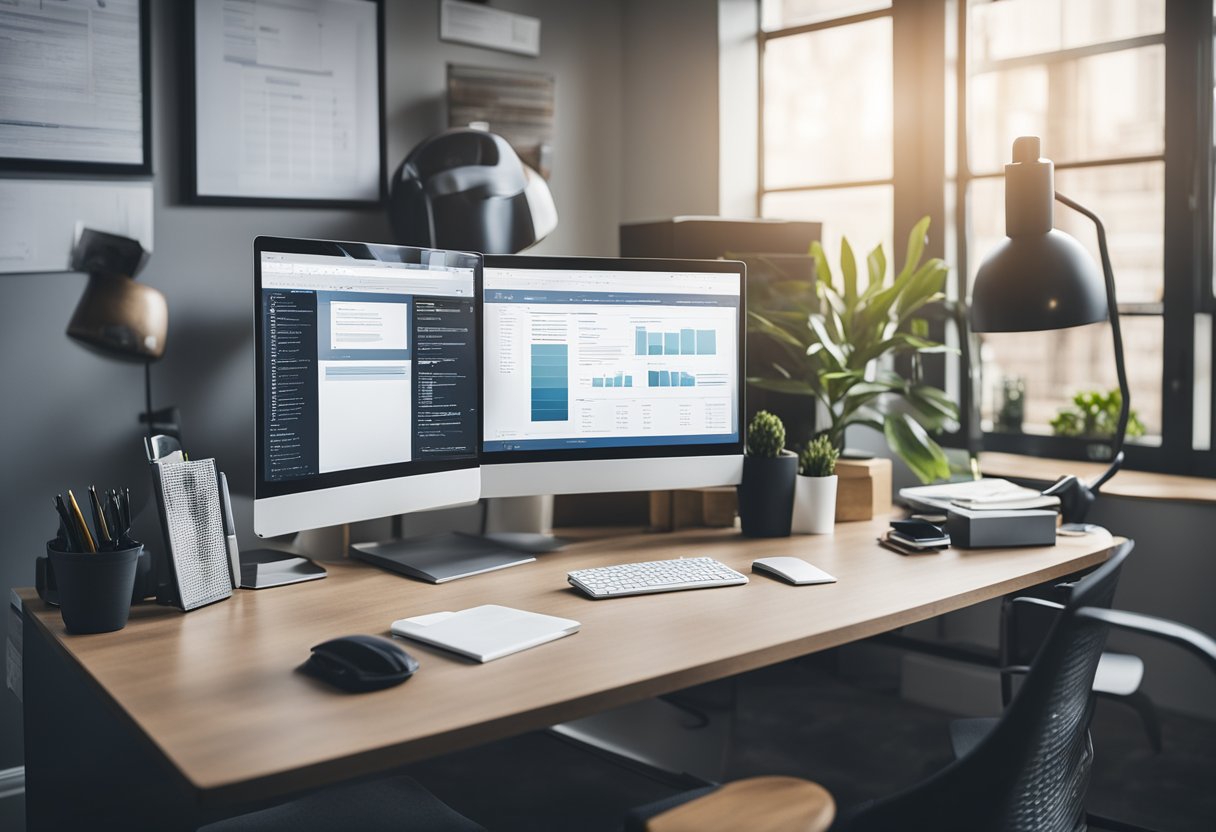
What are the essentials for setting up a thrilling home office for graphic design?
To set up a thrilling home office for graphic design, you need to have the right equipment and software. A high-quality computer, a comfortable chair, a spacious desk, and a good internet connection are essential. You should also invest in a high-resolution monitor, a graphics tablet, and a printer. It is crucial to have the latest versions of Adobe Creative Suite, including Photoshop, Illustrator, and InDesign.
How can you create an inspiring interior for a graphic designer’s home office?
Creating an inspiring interior for a graphic designer’s home office is all about personal expression. You should choose a colour scheme that reflects your personality and style. You can add artwork, posters, and prints to the walls to create a visually stimulating environment. Natural light is essential, so try to position your desk near a window. You can also add plants and other decorative elements to enhance the ambiance.
What steps should you take to kick-start a graphic design business from your own abode?
To kick-start a graphic design business from your own abode, you need to have a solid business plan. You should research your market, identify your target audience, and develop a brand identity. You should also create a portfolio of your work and set up a website to showcase your skills. It is crucial to establish a network of contacts and promote your services through social media and other marketing channels.
Which books should not be missed for an exhilarating graphic design home library?
There are many books that should not be missed for an exhilarating graphic design home library. Some of the must-reads include “Thinking with Type” by Ellen Lupton, “The Elements of Typographic Style” by Robert Bringhurst, and “Grid Systems in Graphic Design” by Josef Müller-Brockmann. Other essential titles include “Logo Design Love” by David Airey, “The Non-Designer’s Design Book” by Robin Williams, and “How to be a Graphic Designer Without Losing Your Soul” by Adrian Shaughnessy.
How do graphic designers craft a work-life balance when working from home?
Crafting a work-life balance when working from home can be challenging for graphic designers. It is essential to establish a routine and set boundaries between work and personal life. You should create a dedicated workspace and try to stick to regular working hours. It is also crucial to take breaks and engage in physical activity to avoid burnout. You can also use productivity tools and apps to manage your time and stay organised.
What are the top tips for maintaining productivity in a home office for graphic designers?
Maintaining productivity in a home office for graphic designers requires discipline and focus. You should set daily, weekly, and monthly goals and track your progress. It is crucial to eliminate distractions and create a quiet, clutter-free workspace. You can also use time-tracking apps and software to monitor your productivity and identify areas for improvement. It is also essential to take regular breaks and stay hydrated to maintain focus and energy.

